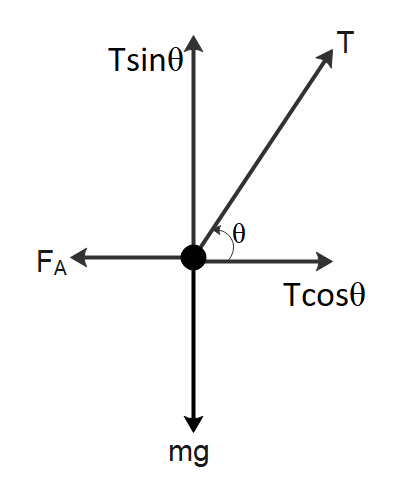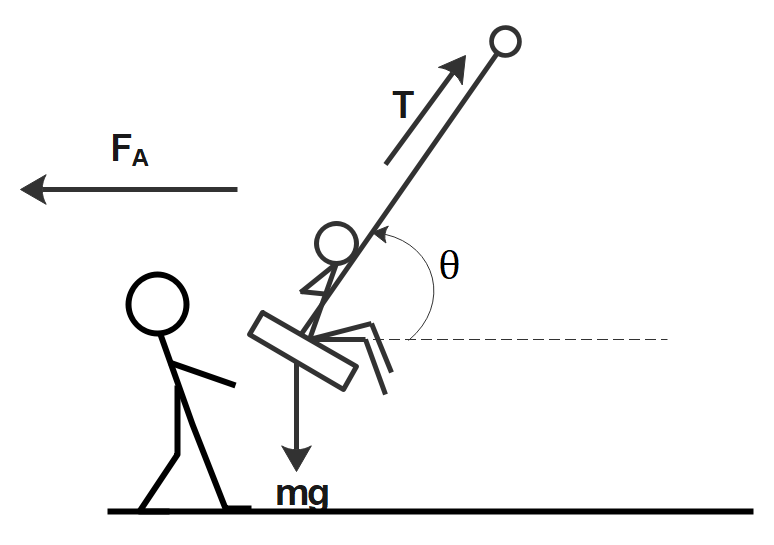Answer
428.7k+ views
Hint: In the problem, they’ve given a child-swing system. They asked us to find the force that must act on the object to keep it in equilibrium. In order to find it, we need to know the tension in the string. From this, we can calculate the horizontal component of tension which will be the force needed to be applied.
Complete answer:
Let us draw a simple free body diagram of forces acting on the swing.

The weight mg of the swing and the child is acting downwards. The tension in the string is acting at an angle θ to the horizontal. Resolving the tension into components, we will have the vertical component balancing the weight of the swing-child system. Now, the force FA must be applied towards the left to balance the horizontal component of tension.
Considering the vertical forces acting on the system, we will have
$T\sin \theta = mg$
They’ve given the angle $\theta = {30.0^o}$ and the weight $mg = 100N$. Substituting the quantities in the formula we will have
$\eqalign{
& T\sin \theta = mg \cr
& \Rightarrow T\sin {30.0^o} = 100 \cr
& \Rightarrow T \times \dfrac{1}{2} = 100 \cr
& \Rightarrow T = 200N \cr} $
Now that we have the tension of the string, we can find the horizontal component and equate it to the force to be applied as follows
$\eqalign{
& T\cos \theta = {F_A} \cr
& \Rightarrow {F_A} = 100\cos {30.0^o} \cr
& \Rightarrow {F_A} = 100 \times \dfrac{{\sqrt 3 }}{2} = 86.6 \cr
& \therefore {F_A} = 86.6N \cr} $
So, the correct answer is “Option C”.
Note:
Always draw a free body diagram, to analyze the forces acting on the system. It helps in knowing the cancellation or interaction of forces and the direction of acceleration of the body. Though in our problem there’s no acceleration, it helps find the equilibrium of forces. In a free body diagram (or F.B.D.) consider the object of interest as a point object and draw the forces acting on it.
Complete answer:
Let us draw a simple free body diagram of forces acting on the swing.

The weight mg of the swing and the child is acting downwards. The tension in the string is acting at an angle θ to the horizontal. Resolving the tension into components, we will have the vertical component balancing the weight of the swing-child system. Now, the force FA must be applied towards the left to balance the horizontal component of tension.
Considering the vertical forces acting on the system, we will have
$T\sin \theta = mg$
They’ve given the angle $\theta = {30.0^o}$ and the weight $mg = 100N$. Substituting the quantities in the formula we will have
$\eqalign{
& T\sin \theta = mg \cr
& \Rightarrow T\sin {30.0^o} = 100 \cr
& \Rightarrow T \times \dfrac{1}{2} = 100 \cr
& \Rightarrow T = 200N \cr} $
Now that we have the tension of the string, we can find the horizontal component and equate it to the force to be applied as follows
$\eqalign{
& T\cos \theta = {F_A} \cr
& \Rightarrow {F_A} = 100\cos {30.0^o} \cr
& \Rightarrow {F_A} = 100 \times \dfrac{{\sqrt 3 }}{2} = 86.6 \cr
& \therefore {F_A} = 86.6N \cr} $
So, the correct answer is “Option C”.
Note:
Always draw a free body diagram, to analyze the forces acting on the system. It helps in knowing the cancellation or interaction of forces and the direction of acceleration of the body. Though in our problem there’s no acceleration, it helps find the equilibrium of forces. In a free body diagram (or F.B.D.) consider the object of interest as a point object and draw the forces acting on it.
Recently Updated Pages
When people say No pun intended what does that mea class 8 english CBSE

Name the states which share their boundary with Indias class 9 social science CBSE

Give an account of the Northern Plains of India class 9 social science CBSE

Change the following sentences into negative and interrogative class 10 english CBSE

Advantages and disadvantages of science

10 examples of friction in our daily life

Trending doubts
Difference between Prokaryotic cell and Eukaryotic class 11 biology CBSE

Which are the Top 10 Largest Countries of the World?

Fill the blanks with the suitable prepositions 1 The class 9 english CBSE

Differentiate between homogeneous and heterogeneous class 12 chemistry CBSE

Difference Between Plant Cell and Animal Cell

10 examples of evaporation in daily life with explanations

Give 10 examples for herbs , shrubs , climbers , creepers

Write a letter to the principal requesting him to grant class 10 english CBSE

How do you graph the function fx 4x class 9 maths CBSE




